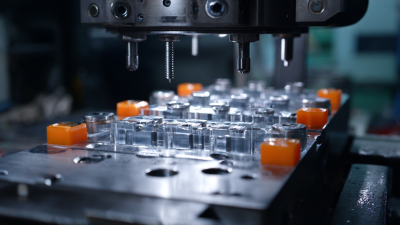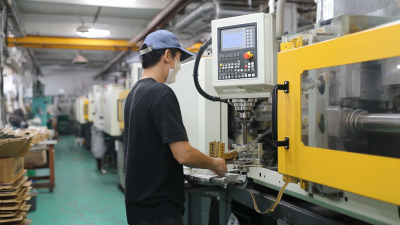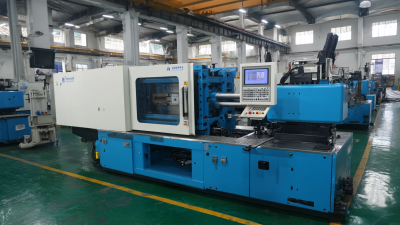What Are the Essential Components of Plastic Injection Machine Parts?
In the world of manufacturing, plastic injection molding stands out as a highly efficient and versatile process for creating a wide range of plastic parts. At the heart of this process lie the essential components of plastic injection machine parts, which play a crucial role in determining the quality, speed, and efficiency of production. Understanding these components not only helps in appreciating their significance but also highlights the benefits they bring to the manufacturing landscape. From the injection unit to the clamping system, each part has a specific function that contributes to the overall performance of the machine. In this blog, we will delve into the key elements of plastic injection machine parts and explore the advantages they offer in enhancing productivity, reducing waste, and ensuring consistent product quality in the plastic manufacturing industry.

Key Parts of Plastic Injection Machines: An Overview of Their Functions
Plastic injection machines are complex systems with several key components that work together to facilitate the molding process. Among the most critical parts are the hopper, where plastic pellets are fed into the machine, and the barrel, which heats and melts the material. The screw acts as a pump that pushes the molten plastic towards the mold, ensuring a steady flow. Each of these components plays a vital role in determining the efficiency and quality of the final product.
Another essential element is the mold itself, which shapes the molten plastic into the desired form. The clamping unit secures the mold during the injection phase, preventing it from opening under pressure. Additionally, the control system manages the machine's operations, allowing for precise adjustments in temperature, pressure, and timing. Understanding these key parts and their functions is crucial for anyone involved in the plastic manufacturing industry, as they directly impact production efficiency and product integrity.

Understanding the Role of Injection Units in Plastic Manufacturing Processes
The injection unit of a plastic injection molding machine plays a critical role in the manufacturing process. It consists of components such as the injection nozzle, barrel, and screw, which work together to melt the plastic resin and inject it into the mold. Recent industry reports indicate that advancements in the design of injection units can lead to increased efficiency and reduced cycle times. For instance, innovative screw designs have enhanced the melting and mixing processes, resulting in more uniform material properties and higher-quality end products.
Moreover, the integration of technologies such as Six Sigma and machine learning into injection molding processes has shown promise in identifying defects and improving production consistency. A case study highlighted that implementing these techniques allowed manufacturers to decrease defect rates by up to 30%, significantly enhancing the overall quality of the plastic parts produced. This improvement not only reduces waste but also accelerates the time to market, further underscoring the importance of a well-functioning injection unit in modern plastic manufacturing.
The Importance of Clamping Systems in Ensuring Precise Molding
The clamping system is a critical component of plastic injection machines, playing a vital role in ensuring precision during the molding process. This system securely holds the mold halves together under high pressure, preventing any leaks or misalignments that could compromise the quality of the final product. A robust clamping system can significantly impact the uniformity and accuracy of molded parts, making it essential for manufacturers looking to maintain high standards in production.
Moreover, the efficiency of the clamping mechanism directly affects cycle times and overall productivity. A well-designed clamping system allows for rapid opening and closing of the mold, reducing downtime and increasing throughput. Manufacturers must consider factors such as the clamping force, speed, and control mechanisms to find the optimum balance between stability and efficiency. By investing in advanced clamping technologies, companies can enhance their molding operations and deliver superior products to their customers.
What Are the Essential Components of Plastic Injection Machine Parts?
| Component | Function | Material | Importance in Clamping |
|---|---|---|---|
| Clamping Unit | Holds the mold in place during injection | Steel or Aluminum | Critical for maintaining mold alignment and integrity |
| Hydraulic System | Provides the pressure required to close the mold | Hydraulic Fluid and Seals | Essential for the proper functioning of the clamping unit |
| Tie Bars | Support the mold and absorb operational stresses | Steel | Provides stability required during the injection process |
| Mold Base | Houses the mold components | Aluminum or Steel | Supports clamping force and ensures accurate mold positioning |
| Clamp Cylinder | Activates the clamping mechanism | Steel | Integral for ensuring secure mold closure |
Material Considerations: How Different Plastics Affect Machine Components
When it comes to plastic injection machines, the choice of materials significantly impacts the performance and longevity of their components. Different types of plastics not only influence the characteristics of the finished products but also the durability and maintenance requirements of the injection machine parts. According to a report by Grand View Research, the global plastic injection molding market is anticipated to reach $459.3 billion by 2027, indicating the growing importance of efficient and robust injection machine components.
 Materials such as ABS, polypropylene, and polycarbonate each possess unique properties that affect machine components. For instance, ABS is known for its toughness and impact resistance, making it a preferred choice for parts that endure physical stress. Conversely, polypropylene is lighter and exhibits greater resistance to chemical exposure, which can extend the lifespan of components in certain applications. A study by the American Society for Testing and Materials (ASTM) reveals that the mechanical properties of these plastics can change significantly under varying thermal conditions, underlining the need for manufacturers to carefully select materials that match their specific operational requirements.
Materials such as ABS, polypropylene, and polycarbonate each possess unique properties that affect machine components. For instance, ABS is known for its toughness and impact resistance, making it a preferred choice for parts that endure physical stress. Conversely, polypropylene is lighter and exhibits greater resistance to chemical exposure, which can extend the lifespan of components in certain applications. A study by the American Society for Testing and Materials (ASTM) reveals that the mechanical properties of these plastics can change significantly under varying thermal conditions, underlining the need for manufacturers to carefully select materials that match their specific operational requirements.
Maintenance Best Practices for Prolonging the Life of Injection Machine Parts
To prolong the life of injection machine parts, implementing effective maintenance practices is crucial. Regular inspections can help identify wear and tear early, thus preventing major breakdowns. By keeping components clean and lubricated, you can minimize friction and extend the lifespan of moving parts. In addition, maintaining the correct temperature and pressure settings can avoid unnecessary stress on the machinery, ensuring optimal performance.
Here are a couple of tips for maintaining your injection machine parts effectively: First, establish a routine maintenance schedule that includes checking for signs of wear, such as cracking or corrosion, particularly in critical components. Second, consider leveraging AI predictive maintenance tools that can analyze usage patterns and predict potential failures before they disrupt operations. These proactive measures not only enhance machinery longevity but can also boost factory uptime significantly. By investing in refurbishment and re-manufacturing processes, manufacturers can effectively restore parts rather than replacing them, further extending the lifecycle of essential equipment.
Related Posts
-

Custom Solutions for Efficient Injection Molding Machine Molds in Global Industries
-

Exploring Alternative Methods to Automotive Injection Molding for Efficient Production
-

The Future of Cost Efficiency in Injection Moulding Machines with Emerging Technologies
-

2025 Trends in Overmolding Injection Molding: How to Choose the Best Solutions for Global Sourcing
-

Top 7 Import Export Certifications for Best Plastic Injection Molding Machines in 2023
-

5 Reasons Insert Molding is Revolutionizing Modern Manufacturing
Submit a quote request or book a design consultation
Plastimold Products is an end-to-end product development and manufacturing team. We provide product design, engineering, prototyping, tooling, plastic injection molding, assembly, packaging and fulfillment. We work with any size company from start-ups to enterprises from all around the world.
I have a product I want to manufacture
I have a product that is already designed and now needs to be manufactured.
I need a manufacturer to optimize my product for injection molding, help choose the correct material, and manage the product production.
I have tooling that I want to transfer or modify, or I need to produce new tooling.
I need design and engineering support
I have a product concept that I want to be designed and brought to market.
I have a product that needs to be reviewed, improved or DFM’ed.
I am looking for a manufacturer to provide an end-to-end solution, from design and development to inventory, marketing, and sales.
©2022 Plastimold Products - Privacy policy - Terms and Conditions

